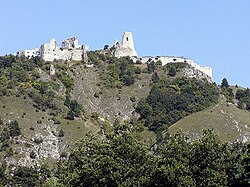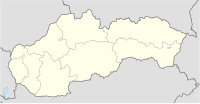Čachtice Castle
| Čachtice Castle | |
|---|---|
| Čachtice, Slovakia | |

View on the castle ruins from the south.
|
|
| Coordinates | 48°43′30″N 17°45′39″E / 48.725°N 17.760833°E |
| Site information | |
| Condition | Ruined |
| Site history | |
| Built | 13th century |
| Materials | Limestone |
| Demolished | 1799 |
Čachtice Castle (Slovak pronunciation: [tʃaxtʲɪtse]; Slovak: Čachtický hrad, Hungarian: Csejte vára) is a castle ruin in Slovakia next to the village of Čachtice. It stands on a hill featuring rare plants, and has been declared a national nature reserve for this reason. The castle was a residence and later the prison of the Countess Elizabeth Báthory, who is alleged to have been the world's most prolific female serial killer.
Čachtice was built in the mid-13th century by Kazimir from the Hont-Pázmány gens as a sentry on the road to Moravia. Later, it belonged to Máté Csák, the Stibor family, and then to the famous Bloody Lady Elizabeth Báthory. Čachtice, its surrounding lands and villages, was a wedding gift from the Nádasdy family upon Elizabeth's marriage to Ferenc Nádasdy in 1575.
Originally, Čachtice was a Romanesque castle with an interesting horseshoe shaped residence tower. It was turned into a Gothic castle later and its size was increased in the 15th and 16th centuries. A Renaissance renovation followed in the 17th century. Finally, in 1708 the castle was captured and plundered by the rebels of Ferenc II Rákoci AKA Francis II Rákóczi. It has been in decay since.
Along with Orava Castle, Čachtice Castle was used as the location for Count Orlok's castle in Nosferatu.
...
Wikipedia

